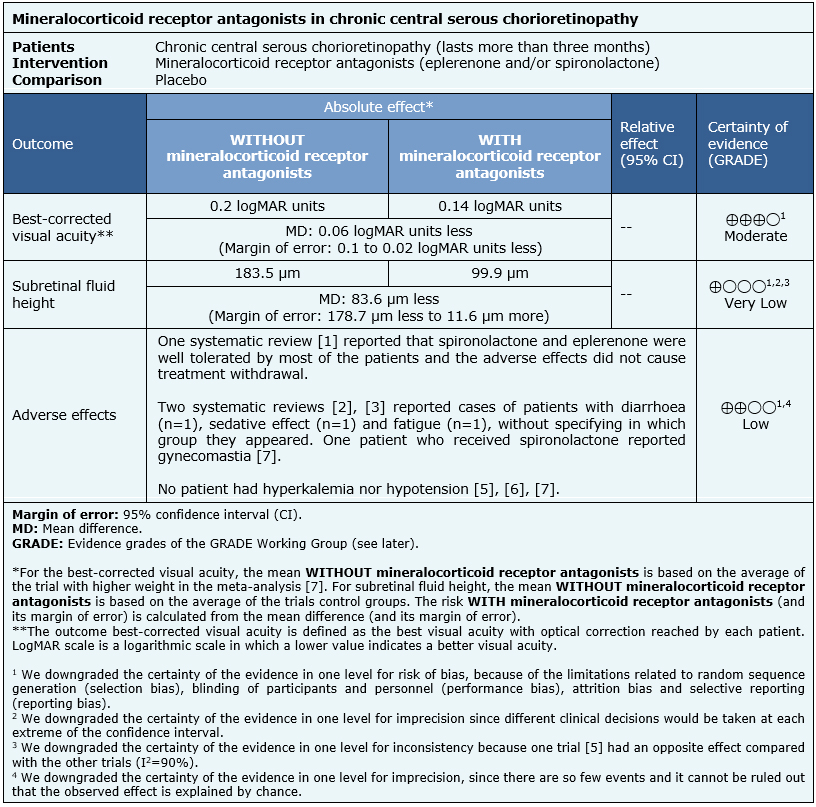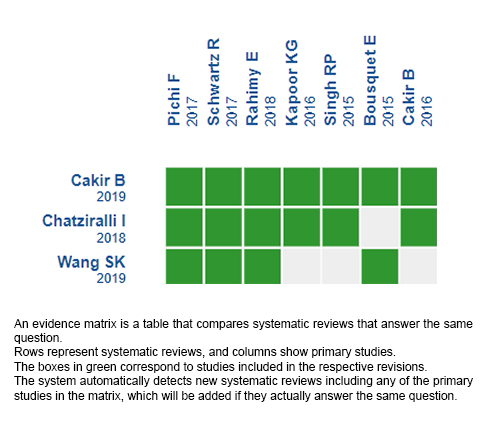Epistemonikos summaries
← vista completaPublished on September 29, 2020 | http://doi.org/10.5867/medwave.2020.08.8035
Mineralocorticoid receptor antagonists in chronic central serous chorioretinopathy
Antagonistas de mineralocorticoides en coriorretinopatía central serosa crónica
Abstract
INTRODUCTION Central serous chorioretinopathy consists of the leakage of fluid from the choroid and its accumulation into the subretinal space. Its chronic form is associated with permanent vision loss. Mineralocorticoid receptor antagonists are an alternative treatment for this condition, although there is no clear evidence about their effectiveness.
METHODS We searched in Epistemonikos, the largest database of systematic reviews in health, which is maintained by screening multiple information sources, including MEDLINE, EMBASE, Cochrane, among others. We extracted data from the systematic reviews, reanalyzed data of primary studies, conducted a meta-analysis and generated a summary of findings table using the GRADE approach.
RESULTS AND CONCLUSIONS We identified three systematic reviews including 22 studies overall and four of them are randomized trials. We concluded that in chronic central serous chorioretinopathy, mineralocorticoid receptor antagonists probably make little or no difference to best-corrected visual acuity. We are uncertain whether this intervention reduces subretinal fluid height because the certainty of the evidence is very low. Furthermore, this intervention may make little or no difference in terms of adverse effects, but the certainty of the evidence is low.
Problem
Central serous chorioretinopathy consists of the leakage of fluid from the choroid and the retinal pigment epithelium into the subretinal space, which generate a serous retinal detachment. There is not a universally accepted classification for this disease, but in general terms, it is chronic when its course is longer than three months. In this case, there is a high risk of permanent vision loss.
There is not a standard treatment for chronic central serous chorioretinopathy and there are several alternatives of management: photodynamic therapy, focal laser photocoagulation, micropulse diode laser, intravitreal anti‐vascular endothelial growth factor agents (anti-VEGF) and mineralocorticoid receptor antagonists (eplerenone and spironolactone). The association between central serous chorioretinopathy and the overactivation of mineralocorticoid receptors localized in the choroid supports the employment of these drugs.
Mineralocorticoid receptor antagonists are an affordable treatment especially when there is not a leakage point in fluorescein angiography, or when it has a macular localization. Nevertheless, their effectiveness is unclear.
Methods
We searched in Epistemonikos, the largest database of systematic reviews in health, which is maintained by screening multiple information sources, including MEDLINE, EMBASE, Cochrane, among others, to identify systematic reviews and their included primary studies. We extracted data from the identified reviews and reanalyzed data from primary studies included in those reviews. With this information, we generated a structured summary denominated FRISBEE (Friendly Summary of Body of Evidence using Epistemonikos) using a pre-established format, which includes key messages, a summary of the body of evidence (presented as an evidence matrix in Epistemonikos), meta-analysis of the total of studies when it is possible, a summary of findings table following the GRADE approach and a table of other considerations for decision-making.
|
Key messages
|
About the body of evidence for this question
|
What is the evidence. |
We identified three systematic reviews [1], [2], [3] with 22 primary studies [4], [5],[6],[7], [8], [9], [10], [11], [12], [13], [14], [15], [16], [17], [18], [19], [20], [21], [22], [23], [24], [25], four of which are randomized control trials [4], [5], [6], [7]. The table and summary are based on the randomized trials, as the observational studies did not increase the level of certainty of the evidence nor added any additional relevant information. |
|
What types of patients were included* |
All trials included patients with chronic central serous chorioretinopathy, defined by the systematic reviews as central serous chorioretinopathy with a course longer than three months. The best-corrected visual acuity for the control group (placebo or observation) on average was 0.24 logMAR scale units. For the intervention group, this parameter was 0.36 logMAR [4], [5], [6], [7]. The baseline subretinal fluid height was on average 198.5 micrometres (μm) for the control group and 210.5 μm for the intervention group [4], [5], [6], [7]. |
|
What types of interventions were included* |
All trials evaluated mineralocorticoid receptor antagonists. Two of them [4], [5] evaluated eplerenone, one trial [6] evaluated spironolactone and another trial [7] evaluated the combination of spironolactone and eplerenone. Two trials [4], [5] evaluated the administration of 25 mg daily of oral eplerenone for one week followed by 50 mg daily for nine weeks [4] or 12 weeks [5]. Another trial [6], evaluated the administration of 50 mg daily of spironolactone for four weeks. In the last trial [7], the patients received 50 mg daily of eplerenone, followed by 50 mg daily of spironolactone for four weeks. Three trials [4], [5], [6] compared the intervention with placebo and one trial [7] compared it with placebo and spironolactone.. |
|
What types of outcomes |
The trials evaluated several outcomes grouped by the systematic reviews as follows:
|
* Information about primary studies is not extracted directly from primary studies but from identified systematic reviews, unless otherwise stated.
Summary of findings
The information about the effect of mineralocorticoid receptor antagonists (spironolactone and eplerenone) in chronic central serous chorioretinopathy is based in four randomized controlled trials (75 eyes) [4], [5], [6], [7].
Four trials measured the outcomes best-corrected visual acuity (logMAR scale) and subretinal fluid height (μm) (75 eyes) [4], [5], [6], [7].
None of the systematic reviews enabled data extraction regarding adverse effects to perform a meta-analysis. In consequence, the information about this outcome is presented as a narrative synthesis.
The summary of findings is as follows:
- Mineralocorticoid receptor antagonists in chronic central serous chorioretinopathy probably make little or no difference to the best-corrected visual acuity (moderate certainty evidence).
- We are uncertain whether mineralocorticoid receptor antagonists in chronic central serous chorioretinopathy reduces subretinal fluid height because the certainty of the evidence has been assessed as very low.
- Mineralocorticoid receptor antagonists in chronic central serous chorioretinopathy may make little or no difference in terms of adverse effects (low certainty evidence)..

| Follow the link to access the interactive version of this table (Interactive Summary of Findings – iSoF) |

Other considerations for decision-making
|
To whom this evidence does and does not apply |
|
| About the outcomes included in this summary |
|
| Balance between benefits and risks, and certainty of the evidence |
|
| Resource considerations |
|
| What would patients and their doctors think about this intervention |
|
|
Differences between this summary and other sources |
|
| Could this evidence change in the future? |
|
How we conducted this summary
Using automated and collaborative means, we compiled all the relevant evidence for the question of interest and we present it as a matrix of evidence.

Follow the link to access the interactive version: Mineralocorticoid receptor antagonists in chronic central serous chorioretinopathy.
Notes
The upper portion of the matrix of evidence will display a warning of “new evidence” if new systematic reviews are published after the publication of this summary. Even though the project considers the periodical update of these summaries, users are invited to comment in Medwave or to contact the authors through email if they find new evidence and the summary should be updated earlier.
After creating an account in Epistemonikos, users will be able to save the matrixes and to receive automated notifications any time new evidence potentially relevant for the question appears.
This article is part of the Epistemonikos Evidence Synthesis project. It is elaborated with a pre-established methodology, following rigorous methodological standards and internal peer review process. Each of these articles corresponds to a summary, denominated FRISBEE (Friendly Summary of Body of Evidence using Epistemonikos), whose main objective is to synthesize the body of evidence for a specific question, with a friendly format to clinical professionals. Its main resources are based on the evidence matrix of Epistemonikos and analysis of results using GRADE methodology. Further details of the methods for developing this FRISBEE are described here (http://dx.doi.org/10.5867/medwave.2014.06.5997)
Epistemonikos foundation is a non-for-profit organization aiming to bring information closer to health decision-makers with technology. Its main development is Epistemonikos database (www.epistemonikos.org).
Potential conflicts of interest
The authors do not have relevant interests to declare.

